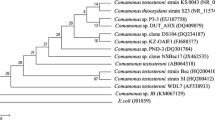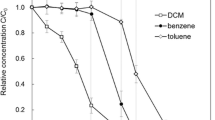Abstract
Various bacterial isolates from enrichments with isopropylbenzene (cumene), toluene or phenol as carbon and energy sources were tested as to their potential to oxidize trichloroethene (TCE). In contrast to toluene and phenol, all isolates enriched on isopropylbenzene were able to oxidize TCE. Two isolates, strain JR1 and strain BD1, were identified as Pseudomonas spec. and as Rhodococcus erythropolis, respectively. TCE oxidation was accompanied by the liberation of stoichiometric amounts of chloride. Initial TCE oxidation rate increased proportional to the substrate concentration from 25 to 200 μM TCE. Maximal initial TCE-degradation rates found here were 4 to 5 nmol · min-1 · mg protein-1. The TCE degradation rate decreased with time. The two isolates showed a temperature optimum for TCE degradation between 10 and 20 °C. In addition to TCE, R. erythropolis BD1 degraded only cis- and trans-dichloroethene whereas Pseudomonas spec. JR1 was able to oxidize also 1,1-dichloroethene, vinyl chloride, trichloroethane, and 1,2-dichloroethane.
Similar content being viewed by others
Abbreviations
- DMF:
-
dimethylformamide
- TCE:
-
trichloroethene
References
Arciero D, Vannell T, Logan M, Hooper AB (1989) Degradation of trichloroethylene by the ammonia-oxidizing bacterium Nitrosomonas europaea. Biochem Biophys Res Commun 159: 640–643
Claus D, Lack P, Neu B (1983) Catalogue of strains. German Collection of Microorganisms, Gesellschaft für Biotechnologische Forschung mbH, Braunschweig
Eaton WR, Timmis KN (1984) Genetics of isopropylbenzene metabolism in strain ipba. In: Klug JM, Reddy CA (eds) Current perspectives in microbial ecology. American Society for Microbiology, Washington D.C, pp 699–701
Eaton WR, Timmis KN (1986) Characterization of a plasmid-specified pathway for catabolism of isopropylbenzene in Pseudomonas putida RE204. J Bacteriol 168: 123–131
Ewers J, Freier-Schröder D, Knackmuss H-J (1990) Selection of trichloroethene (TCE) degrading bacteria that resist inactivation by TCE. Arch Microbiol 154: 410–413
Fogel MM, Taddeo AR (1986) Biodegradation of chlorinated ethenes by a methane-utilizing mixed culture. Appl Environ Microbiol 51: 720–724
Folsom BR, Chapman PJ, Pritchard PH (1990) Phenol and trichloroethylene degradation by Pseudomonas cepacia G4: kinetics and interactions between substrates. Appl Environ Microbiol 56: 1279–1285
Harker AR, Kim Y (1990) Trichloroethylene degradation by two independent aromatic-degrading pathways in Alcaligenes eutrophus JMP134. Appl Environ Microbiol 56: 1179–1181
Henry SM, Grbic-Galic D (1991) Influence of endogenous and exogenous electron donors and trichloroethylene oxidation toxicity on trichloroethylene oxidation by methanotrophic cultures from a groundwater aquifer. Appl Environ Microbiol 57: 236–244
Jigami Y, Omori T, Minoda Y (1975) The degradation of isopropylbenzene and isobutylbenzene by Pseudomonas sp. Agric Biol Chem 39: 1781–1788
Maniatis T, Fritsch TF, Sambrook J (1982) Molecular cloning. A laboratory manual. Cold Spring Harbor Laboratory, Cold Spring Harbor, New York
Nelson MJK, Montgomery SO, Mahaffeyl WR, Pritchard PH (1987) Biodegradation of trichloroethylene and involvement of an aromatic biodegradative pathway. Appl Environ Microbiol 53: 949–954
Oldenhuis R, Vink RLJM, Janssen DB, Witholt B (1989) Degradation of chlorinated aliphatic hydrocarbons by Methylosinus trichosporium OB3b expressing soluble methane monooxygenase. Appl Environ Microbiol 55: 2819–2826
Omori T, Jigami Y, Minoda Y (1975) Isolation, identification and substrate assimilation specificity of some aromatic hydrocarbon utilizing bacteria. Agric Biol Chem 39: 1775–1779
Schmidt K, Liaaen-Jensen S, Schlegel H-G (1963) Die Carotinoide der Thiorhodaceae. I. Okenon als Hauptcarotinoid von Chromatium okenii Perty. Arch Mikrobiol 46: 117–126
Shields MS, Montgomery SO, Chapman PJ, Cuskey SM, Pritchard PH (1989) Novel pathway of toluene catabolism in the trichloroethylene-degrading bacterium G4. Appl Environ Microbiol 55: 1624–1629
Shields MS, Montgomery SO, Cuskey SM, Chapman PJ, Pritchard PH (1991) Mutants of Pseudomonas cepacia G4 defective in catabolism of aromatic compounds and trichloroethylene. Appl Environ Microbiol 57: 1935–1941
Tschech A, Pfennig N (1984) Growth yield increase linked to caffeate reduction in Acetobacterium woodii. Arch Microbiol 137: 163–167
Tsien H-C, Brusseau GA, Hanson RS, Wackett LP (1989) Biodegradation of trichloroethylene by Methylosinus trichosporium OB3b. Appl Environ Microbiol 55: 3155–3161
Wackett LP, Gibson DT (1988) Degradation of trichloroethylene by toluene dioxygenase in whole-cell studies with Pseudomonas putida F1. Appl Environ Microbiol 54: 1703–1708
Wackett LP, Brusseau GA, Householder SR, Hanson RS (1989) Survey of microbial oxygenases: trichloroethylene degradation by propane-oxidizing bacteria. Appl Environ Microbiol 55: 2960–2964
Wilson TW, Wilson BH (1985) Biotransformation of trichloroethylene in soil. Appl Environ Microbiol 49: 242–243
Winter RB, Yen K-M, Ensley BD (1989) Efficient degradation of trichloroethylene by a recombinant Escherichia coli. Bio/Technology 7: 282–285
Zylstra GJ, Wackett PL, Gibson DT (1989) Trichloroethylene degradation by Escherichia coli containing the cloned Pseudomonas putida F1 toluene dioxygenase genes. Appl Environ Microbiol 55: 3162–3166
Author information
Authors and Affiliations
Rights and permissions
About this article
Cite this article
Dabrock, B., Riedel, J., Bertram, J. et al. Isopropylbenzene (cumene) — a new substrate for the isolation of trichloroethene-degrading bacteria. Arch. Microbiol. 158, 9–13 (1992). https://doi.org/10.1007/BF00249058
Received:
Accepted:
Issue Date:
DOI: https://doi.org/10.1007/BF00249058




